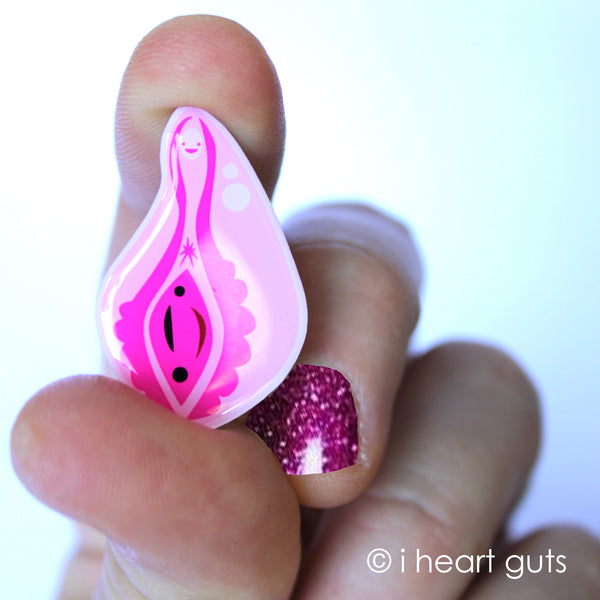
What do obstetricians Dr. Ernst Grafenberg and Dr. Alexander Skene have in common? Parts of the vagina are named after them! Here are all the biologically female parts named after men:
1. Fallopian Tubes are part of the uterus named after 16th century Italian anatomist Gabriele Fallopio;
2. The G-spot is a Bermuda Triangle-esque part of the vagina (it's existence is not proven + it may actually be part of the embedded clitoris and female prostate) named after 1900s physician Dr. Ernest Grafenberg:
3. Skene's Glands are located on the wall of the vagina, and are named for Dr. Alexander Skene, a 19th century gynecologist. The gland was renamed the female prostate in 2002.
4. Bartholin's Glands, which help lubricate the vagina, are named after Caspar Bartholin the Younger, a Danish anatomist who wrote about the glands in the 1600s.
5. Gartner's ducts get their name from Danish anatomist Hermann Treschow Gartner.
6. The Graffian Follicle is an ovarian follicle that secretes hormones that guide the menstrual cycle. Regnier de Graaf --
yet another Danish anatomist -- named this part in the 1600s. He also described the G-spot 300 years before Grafenberg (and a number of women surely discovered it
ages before them).
7. Pouch of Douglas is the area between the uterus and rectum first described in the 1700s by Scottish anatomist Dr. James Douglas, who served as "Physician Extraordinary" to Queen Caroline.
8. Glands of Montgomery are the bumps on areola, men also have them, too, but these glands have different features in women due to estrogen. They are named for Irish obstetrician William Fetherstone Montgomery, who labeled them in the 1800s.
9. Hydati of Morgani are paratubal cysts in women, first described by Italian anatomist Giovanni Battista Morgani in the 1700s. You may wonder -- why? Well, back in anatomy's heyday, pretty much all doctors were men, so they were the first to write down the human body's many nooks and crannies. So even though a woman was 100% likely to be the first to learn about say, the so-called G-spot, from personal experience, she likely talked about it with her partner or friends as "that place that feels good" instead of putting her name on it or writing it down for the ages. There are of course tons of unisex
body parts named after doctors, and plenty of biologically male parts, too:
Sertoli cells are a helper cell for making sperm and check out the
Cave of Retzius --
if you dare (NSFW depending on where you W)! We've got all the body parts you need with
Gynecology Gifts galore. If you need
estrogen gifts,
vagina/vulva gifts, we have those up the proverbial ying yang.
Related Posts

Recently, founder Wendy Bryan Lazar was a guest star on InvisiYouth Podcast. Lazar dives into the origin story of I H...
Read More
We’re 20! This month marks I Heart Guts’ birthday — 20 years of guts, glory, and YOUR incredible stories. So let’s ta...
Read More
Just in! We have new funny colon magnets: 'Don't Hate Us Cuz Ya Anus' and 'Colonoscopy Saved My Ass'
These cute col...
Read More
 What do obstetricians Dr. Ernst Grafenberg and Dr. Alexander Skene have in common? Parts of the vagina are named after them! Here are all the biologically female parts named after men: 1. Fallopian Tubes are part of the uterus named after 16th century Italian anatomist Gabriele Fallopio; 2. The G-spot is a Bermuda Triangle-esque part of the vagina (it's existence is not proven + it may actually be part of the embedded clitoris and female prostate) named after 1900s physician Dr. Ernest Grafenberg: 3. Skene's Glands are located on the wall of the vagina, and are named for Dr. Alexander Skene, a 19th century gynecologist. The gland was renamed the female prostate in 2002. 4. Bartholin's Glands, which help lubricate the vagina, are named after Caspar Bartholin the Younger, a Danish anatomist who wrote about the glands in the 1600s. 5. Gartner's ducts get their name from Danish anatomist Hermann Treschow Gartner. 6. The Graffian Follicle is an ovarian follicle that secretes hormones that guide the menstrual cycle. Regnier de Graaf -- yet another Danish anatomist -- named this part in the 1600s. He also described the G-spot 300 years before Grafenberg (and a number of women surely discovered it ages before them). 7. Pouch of Douglas is the area between the uterus and rectum first described in the 1700s by Scottish anatomist Dr. James Douglas, who served as "Physician Extraordinary" to Queen Caroline. 8. Glands of Montgomery are the bumps on areola, men also have them, too, but these glands have different features in women due to estrogen. They are named for Irish obstetrician William Fetherstone Montgomery, who labeled them in the 1800s. 9. Hydati of Morgani are paratubal cysts in women, first described by Italian anatomist Giovanni Battista Morgani in the 1700s. You may wonder -- why? Well, back in anatomy's heyday, pretty much all doctors were men, so they were the first to write down the human body's many nooks and crannies. So even though a woman was 100% likely to be the first to learn about say, the so-called G-spot, from personal experience, she likely talked about it with her partner or friends as "that place that feels good" instead of putting her name on it or writing it down for the ages. There are of course tons of unisex body parts named after doctors, and plenty of biologically male parts, too: Sertoli cells are a helper cell for making sperm and check out the Cave of Retzius -- if you dare (NSFW depending on where you W)! We've got all the body parts you need with Gynecology Gifts galore. If you need estrogen gifts, vagina/vulva gifts, we have those up the proverbial ying yang.
What do obstetricians Dr. Ernst Grafenberg and Dr. Alexander Skene have in common? Parts of the vagina are named after them! Here are all the biologically female parts named after men: 1. Fallopian Tubes are part of the uterus named after 16th century Italian anatomist Gabriele Fallopio; 2. The G-spot is a Bermuda Triangle-esque part of the vagina (it's existence is not proven + it may actually be part of the embedded clitoris and female prostate) named after 1900s physician Dr. Ernest Grafenberg: 3. Skene's Glands are located on the wall of the vagina, and are named for Dr. Alexander Skene, a 19th century gynecologist. The gland was renamed the female prostate in 2002. 4. Bartholin's Glands, which help lubricate the vagina, are named after Caspar Bartholin the Younger, a Danish anatomist who wrote about the glands in the 1600s. 5. Gartner's ducts get their name from Danish anatomist Hermann Treschow Gartner. 6. The Graffian Follicle is an ovarian follicle that secretes hormones that guide the menstrual cycle. Regnier de Graaf -- yet another Danish anatomist -- named this part in the 1600s. He also described the G-spot 300 years before Grafenberg (and a number of women surely discovered it ages before them). 7. Pouch of Douglas is the area between the uterus and rectum first described in the 1700s by Scottish anatomist Dr. James Douglas, who served as "Physician Extraordinary" to Queen Caroline. 8. Glands of Montgomery are the bumps on areola, men also have them, too, but these glands have different features in women due to estrogen. They are named for Irish obstetrician William Fetherstone Montgomery, who labeled them in the 1800s. 9. Hydati of Morgani are paratubal cysts in women, first described by Italian anatomist Giovanni Battista Morgani in the 1700s. You may wonder -- why? Well, back in anatomy's heyday, pretty much all doctors were men, so they were the first to write down the human body's many nooks and crannies. So even though a woman was 100% likely to be the first to learn about say, the so-called G-spot, from personal experience, she likely talked about it with her partner or friends as "that place that feels good" instead of putting her name on it or writing it down for the ages. There are of course tons of unisex body parts named after doctors, and plenty of biologically male parts, too: Sertoli cells are a helper cell for making sperm and check out the Cave of Retzius -- if you dare (NSFW depending on where you W)! We've got all the body parts you need with Gynecology Gifts galore. If you need estrogen gifts, vagina/vulva gifts, we have those up the proverbial ying yang.





Leave a comment